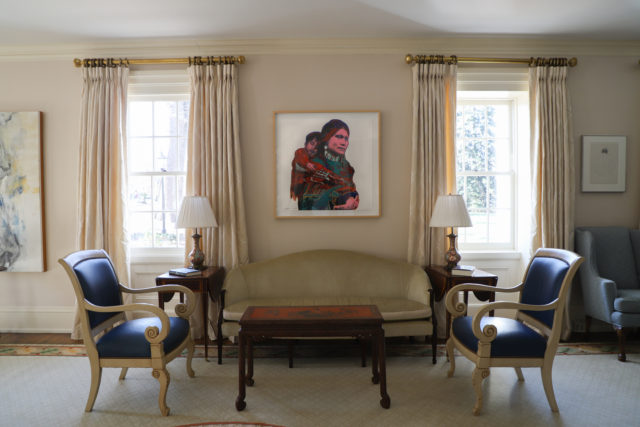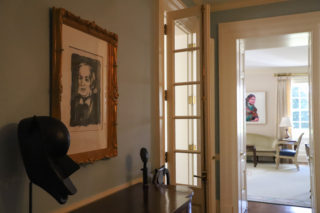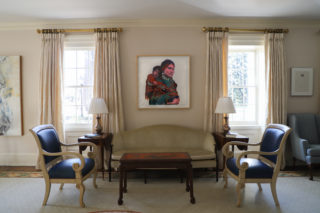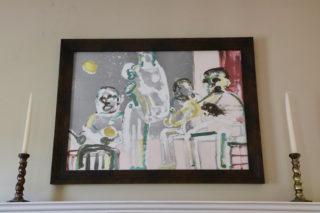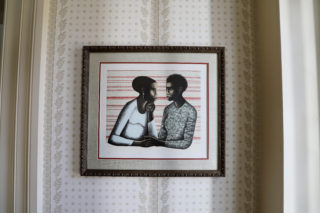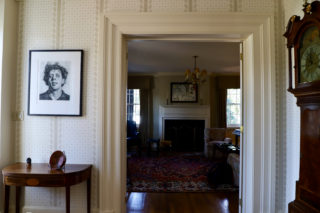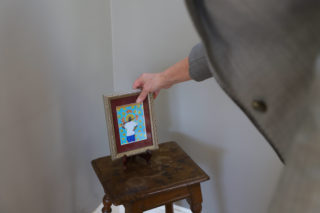by Isabelle Sakelaris ’19, April 2019
On Thursday February 7th, I was lucky enough to receive a tour of the President’s House from President Quillen and her husband, Dr. George McLendon. The President and her husband, avid art collectors, are also privileged to show art from the Davidson College collection on their walls, with artists including Max Ernst, Hans Hoffman, and Romare Bearden, among others. I came prepared with a number of questions to ask President Quillen about her vision for the College art collection, her curatorial scheme, and the importance of studying art in a well-rounded liberal arts education. What follows is a transcription of parts of our conversation. We began in the President’s library and moved through the ground floor of the house. President Quillen and Dr. McLendon noted that, when they came to Davidson, the college’s collection was lacking in certain areas. On their acquisitions program, President Quillen noted:
Carol Quillen: Our collection is very eclectic. Some of it’s modern, there are certain kinds of ceramics, some lithographic art, women’s art…
George McLendon: The college didn’t have much as far as contemporary female African American artists.
CQ: When we moved in here there was a lot of very traditional art. The architecture is very traditional; The house was built in 1837 and the furniture is kind of traditional. There were a lot of beautiful landscapes, and so we, or I thought, we have such amazing art at the college, it would be nice to be able to show some contrast between the architecture of the house and the art that’s on the walls, and so we sort of shifted toward modern and contemporary art.
Quillen and McLendon’s home is filled with much modern and contemporary art made by artists from diverse backgrounds. In the living room, we were greeted by a Hans Hofmann piece, gifted to the college by Jim Pepper, class of 1965, who has been extraordinarily generous to the College–he also made possible the Jaume Plensa sculpture, Waves III, that stands between Belk and Chambers. In addition, the living room houses a David Hockney sketch, as well as an Andy Warhol lithograph, and a painted work by Pr. Doug Houchens, Herb Jackson’s teacher and one of the founders of the Art department at Davidson. Over the mantle hangs a figural work in black and white, with gestural brushstrokes–a piece by contemporary Native American artist, R.C. Gorman, who often paints Navajo women as testament to his membership in the Navajo Tribe. From there we moved to the dining room, where President Quillen pointed out a small painting with a framed postcard placed below it.
CQ: This is the Kehinde Wiley sketch, and this is the finished work, on the postcard. We’re interested in the difference between how he thought about the work initially and what it ended up becoming.
The postcard is indeed very different from the original sketch. Process, and changes over time more generally, seem to be a common theme in the Quillen-McLendon art collection.
GM: That’s a Motherwell. He went through a period where he was recapitulating Japanese painting. That’s something that was gifted to the college…This is an example of the kind of ceramic stuff that I like–it’s a Tang dynasty horse from about 800 CE. And you can compare it with the Han dynasty horse [in the next room], which is about 1000 years older. They get much more stylized as they go through the various dynasties.
President Quillen then drew my attention to an abstract work in the same room–a piece by Herb Jackson, whose support of the Art department has been paramount to its success and continued enrichment.
CQ: This is not a typical Herb Jackson, if you’re familiar with his work– it’s usually really layered. He’s such an important figure at the college.
GM: That’s a Renoir–it’s a portrait of Wagner. It’s actually famous in Art History because Wagner said, “I only have 15 minutes to sit,” so he had to create this in 15 minutes! It has a very modern look because it’s sort of purposefully under-finished. And it’s flanked, of course, by the two African pieces–that’s a Dogon mask and an Ashanti fertility idol, both late 19th Century.
That is actually my favorite piece, and it’s because of Carol. It’s a Tiepolo–not modern. Carol studied Augustine and so this is the cartoon for a fresco outside Florence depicting Augustine dictating the confessions to two little angels, who are cheerfully writing down everything he says. The combination of a classic Old Master and something that Carol liked and cared about was a good reason to acquire it.
I actually like Teipolo’s drawings better than I like the finished works; the drawings give you the essence of how he’s thinking.
CQ: We’re always trying to figure out, because of the College–how do these works come to be? Take the Wiley, for example, you can see how that comes to be.
Lia Newman: I like that idea as a collecting theme–process.
In addition to the theme of process in the works on display at the President’s House is a focus on the bringing together of different cultures and temporal periods.
Isabelle Sakelaris: I like how, moving through the house, there are so many different styles and cultures being juxtaposed. For example, I can see the Hockney and the Wiley at the same time. The intersection between cultures and time periods is really interesting.
CQ: At a college that emphasizes liberal arts education, the importance of being around art is having encounters with it in the ways that you’re describing–the fact that you can see those two things at the same time challenges our categories of perception in ways that really inspire creativity no matter the field.
IS: Right.
CQ: So you might be an artist or you might be a scientist, but that encounter with people who see the world and represent it in different ways, I think, is really important.
IS: Certainly. I was just thinking about the Art and Compassionate Care course, and the psychology exhibition that was recently put on, and the way that the Art department is involved in all of these different courses and different academic disciplines. I think that interdisciplinary emphasis can be academically very fruitful–and unique to Davidson.
CQ: Yes, and even the Representing HIV/AIDS course that Dave Wessner and Ann Fox dreamed up– in part because Ann had done two exhibitions about the body and disability (Re/formations and Staring). And in those conversations they started talking about different kinds of representation and the different ways in which, within different fields, different phenomena are represented–whether it’s the body in medicine and art, or disease, or Patient Zero, with respect to HIV/AIDS–that whole course came out of that encounter with art.
IS: Or even Seeing | Saying, two years ago, that Dr. Van Hillard was involved with.
CQ: Absolutely.
IS: That was special for me as an English and Art History double-major.
CQ: And you know the book Davidson Collects, where students responded to artwork…
IS: Oh! I’ve never heard of that!
LN: We have it in the gallery! It was a project that Brad Thomas and Van Hillard worked on together. It was 100 students, but not necessarily Art or English students. It was not an academic response; they weren’t supposed to do research, they were actually supposed to come and spend time in front of the works and have a response to them.
CQ: This piece was from Emilie Hoke, a student.
LN: That was really an amazing day for her to be in the gallery. Just hanging around her painting, and then to have her first purchase, it was really special.
CQ: I think that’s another thing for us to do here, is to put student artwork in our home. We tried to put this piece above the fireplace, but it was just too big. Basically the idea here is, you know, to have interesting things to look at, interesting contrasts, so that when you walk through you notice the art. We’ve painted the walls in such a way that you do see the art.
Clearly, it is important to President Quillen and to the mission of Davidson College to broaden the scope of students’ thinking, whether that shift in perspective comes from art or from the sciences. Student and faculty participation in the arts is an important aspect of the commitment to an engaged intellectual life at the College. Moving back into the hallway, we continued our conversation.
IS: What do you find is the difference between living with art and seeing it in a gallery or museum context?
CQ: Well in a museum, you’re ready. You’re thinking “I am going to to look at art.” And you go in with the intention of walking through and looking at art, so your brain is in that mode. Whereas if you encounter it when you’re just walking around on your way to class or walking through the campus and you see it, it’s a surprise. The juxtaposition between the natural world and the artistically represented world, or the natural environment and the built environment, to me, is inspiring.
It’s a little bit like living in a multilingual environment versus going into a class to study a language. So when you’re living in a multilingual environment, you’re constantly hearing languages that represent the world in an entirely different way; it’s not that there’s a one-to-one correspondence between a French word and an English word. It’s the same with art. And when you go into a French class to study French, your brain is thinking “I am studying French,” whereas if you live in a world where people are speaking French and Italian and Mandarin and Arabic, all around you, it’s different.
It’s important for us to make sure that people can encounter the art. For example, in Wall Center, we’ve made spaces for art–the video board was built to display art. We’ve talked about if there is any way we could loan art to students, even in residence halls. Faculty have art in college offices–the aim is to get it out on campus.
Much of one’s experience with art is in dealing with its political ramifications and ideologies. I was therefore interested in the way President Quillen conceived of our responsibility as a college to reckon with art and politics on campus.
IS: I know that we have an astounding sculptural program. Pedagogically, all of the sculptures are great examples of a given artist’s work. In a sense, they’re academic, but one-with-the-environment enough that I feel I can walk past the Gormley and say, “oh that’s our Gormley,” and feel ownership of it, but also know that it’s an excellent teaching piece. Do you find that with the inclusion of the Yinka Shonibare work, the collection is becoming more political?
CQ: The short answer to that question is no…I think of art as challenging: challenging convention and challenging what we all believe to be true. But art does that in all kinds of ways. So it challenges, for example, views of the body. You think about the Mapplethorpe photography exhibitions that challenge our notions of what relationships are or challenge our notions of childhood or challenge our notions of what it means to be civilized. So I see art as challenging in the same way that poetry can challenge how language works, and I think when we start to use the word political to refer to art, it turns into, “whose challenges seem more threatening?” That’s a move that people make who like things the way they are. So I would resist the notion of a particular artist as somehow politicizing the collection. I would say that just like Picasso challenged notions of representation, or Dylan Thomas or James Joyce challenged notions of narrative–or the way in which language works–that that’s what art does. I think political is often code for “I don’t like change,” so I would resist that.
IS: Speaking of challenges, I know that the Chuck Close is the College’s, but how do you reckon with the personalities tied to artists, like Chuck Close, when they’ve been accused of sexual misconduct?
CQ: That’s been a long-standing question within the academy–particularly within art and political theory–about the relationship between a person’s work and a person’s life, and how we should think about those two things. The same kinds of things have been said for a long time about Karl Marx–not with respect to sexual misconduct, but with respect to the perceived disjunction between the claims of theory of the work and the way a person lived their lives. I think that’s a very interesting and complex question. And one that we will continue to grapple with. For example, do the implications of Nietzsche’s theory have any relation to totalitarianism or National Socialism? And those are really important questions to ask. I don’t think you can automatically say a person’s work is completely undermined by the ways in which subsequent people use it. Similarly I would say I don’t think a person’s work is completely undermined by the way they lived their life.
IS: And of course, you are putting Close in conversation with female artists and that’s really important as well. Thinking about the entire collection–the way you’ve conceived of it–as a way to grapple with that question. To say “what else are we representing here?”
CQ: The College is thinking now about the relationship of Davidson College to the institution of slavery. How do we think about that? What is our obligation at present to be accountable in some sense, to the future? I really tend to focus on this idea of a shared future. We have to figure out, those of us who are alive right now, what’s our shared future? And it has to be a shared future, because here we all are. So conversation and restorative justice and practices that get us to a place where we can together imagine a shared future that doesn’t paper over the horrific injustices of the past–that’s the obligation. And that has to make room for a kind of restorative justice.
GM: You’ve picked up on an interesting idea, which is we do think about the fact that our collection crosses not only temporal barriers, although it is more contemporary than not, but it also crosses different cultural barriers, and that is purposeful. We could have put a lot of very traditional paintings over the mantle, but we wanted a contemporary Native American artist.
CQ: It’s an interesting question, right? I mean, the relationship of art to morality has always been an interesting question. I think it’s important to ask the question, but I wouldn’t want to over-determine the answers. I do also approach this, I hope, in some spirit of humility and questioning, rather than from a position of judgment.
GM: for example as we head back toward the door, these are examples of very provisional works ranging from sketchbooks to first drawings, all Impressionist. It would be hard to find somebody who had a more controversial lifestyle than Lautrec. He chose to live in a way that others condemned as dissolute. So he’s next to a Whistler, who was about as proper as someone from that era could be. And that’s a Pissarro sketch of his kids, which is really charming. This is a Cassat, of the Alexander family from Philadelphia. The finished version of that is in the Philadelphia Museum of Art, but that was the first take. There’s sort of four very different lifestyles–in one pretty short, self-consistent period. And you’ve got women representing women as well as men representing women.
CQ: These are important questions. Every generation poses them in a different way, so I think it’s important to think about the relationship between how people live and the works they produce. That relationship is always extremely complex. It’s important to think about it and ponder it.
LN: That’s a challenge all institutions are facing, from artists in the collection who are accused of sexual misconduct to confederate statues and portraits and… it remains to be seen how all this shakes out.
CQ: There’s a lot of nuance to it. You could say, “well, there have been conversations about artists in the past–and the one that comes to mind is Sally Mann, where the conversation was about how she produced her photography and whether the way in which she produced the photography of her children was exploitative. That’s a different kind of conversation than saying, well, Marx wasn’t very nice to working class people and therefore, we shouldn’t pay attention to what he said about capitalism, which is a ridiculous statement.
LN: I was thinking about the Nicholas Nixon series, where he photographed his wife and her sisters over 40 years, always in the same pose–so it’s this beautiful series about women and aging and their relationship, and then he was recently accused of sexual misconduct and so, do you disregard that work and what it says about those women and their relationship to each other and aging?
CQ: There are occasions where there’s absolute moral clarity, and there’s a lot of times when there isn’t. It would be nice if there were, but, there’s not and so that’s why humility is so important around these questions, and sometimes grace. These are not humble times–that’s not a virtue we’re seeing in abundance.
LN:I do like the conversation between the two works. And again, it’s a portrait of Philip Glass.
CQ: So you’ve got an artist whose way of creating art challenges conventions of portraiture creating work depicting a composer whose musical compositions are incomprehensible to people who expect them to be anything other than what they are, in conversation with a contemporary African American artist whose representations are usually African American women. In this case, the piece is called Gossip.
The conversation between Gossip and the portrait of Philip Glass is indeed provocative, and perhaps the most representative example of the way President Quillen and Dr. George McLendon conceive of their responsibilities as art collectors–to promote interesting contrasts between works that challenge given notions of normalcy, process, and representation. The diverse collection works toward engendering a sense of empathy and humility in the viewer through figural and abstract works alike, ranging from ancient sculpture to contemporary painting, from China to Davidson. I would like to thank President Quillen and Dr. George McLendon for their generosity in hosting Lia and me, and for speaking to us on the value of art and artistic engagement at Davidson and beyond. It was my pleasure to interview them and to view the works on display in their home, both from their personal collection and the College’s.
Photographs by Olivia Forrester.

